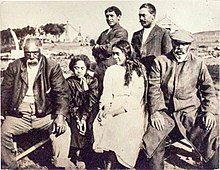 Moriori family, c. 1910 | |
| Total population | |
|---|---|
| approx. 1,000 (2018 census)[1] | |
| Regions with significant populations | |
| Chatham Islands | 36 (2013 census)[2] |
| North Island | 354 (2013 census)[2] |
| South Island | 348 (2013 census)[2] |
| Languages | |
| English, Māori, formerly Moriori | |
| Religion | |
| Christianity including Rātana[2] | |
| Related ethnic groups | |
| Māori people, other Polynesian peoples, Austronesian peoples | |
The Moriori are the first settlers of the Chatham Islands (Rēkohu in Moriori; Wharekauri in Māori).[3] Moriori are Polynesians who came from the New Zealand mainland around 1500 CE,[4][5] which was close to the time of the shift from the archaic to the classic period of Polynesian Māori culture on the mainland.[6][7] Oral tradition records migration to the Chathams in the 16th century.[8][9] The settlers' culture diverged from mainland Māori, and they developed a distinct Moriori language, mythology, artistic expression and way of life.[10] Currently there are around 700 people who identify as Moriori, most of whom no longer live on the Chatham Islands.[11] During the late 19th century some prominent anthropologists proposed that Moriori were pre-Māori settlers of mainland New Zealand, and possibly Melanesian in origin.[12][13]
Early Moriori formed tribal groups based on eastern Polynesian social customs and organisation. Later, a prominent pacifist culture emerged; this was known as the law of nunuku, based on the teachings of the 16th century Moriori leader Nunuku-whenua.[14] This culture made it easier for Taranaki Māori invaders to massacre them in the 1830s during the Musket Wars. This was the Moriori genocide, in which the Moriori were either murdered or enslaved by members of the Ngāti Mutunga and Ngāti Tama iwi,[15] killing or displacing nearly 95% of the Moriori population.
The Moriori, however, were not extinct, and gained recognition as New Zealand's second indigenous people during the next century. Their culture and language underwent a revival, and Moriori names for their islands were prioritised. In February 2020, the New Zealand government signed a treaty with tribal leaders, giving them rights enshrined in law and the Moriori people at large an apology for the past actions of Māori and European settlers. The Crown returned stolen remains of those killed in the genocide, and gifted NZ$18 million in reparations.[16][17] On 23 November 2021, the New Zealand government passed in law the treaty between Moriori and the Crown.[18] The law is called the Moriori Claims Settlement Bill. It includes an agreed summary history that begins with the words "Moriori karāpuna (ancestors) were the waina-pono (original inhabitants) of Rēkohu, Rangihaute, Hokorereoro (South East Island), and other nearby islands (making up the Chatham Islands). They arrived sometime between 1000 and 1400 CE."[19]
- ^ Cite error: The named reference
2018populationwas invoked but never defined (see the help page). - ^ a b c d "Moriori Population and Geography". stats.govt.nz. Statistics New Zealand. Archived from the original on 7 March 2016. Retrieved 5 March 2016.
- ^ Roy, Eleanor Ainge (14 February 2020). "After more than 150 years, New Zealand recognises 'extinct' Moriori people". The Guardian. Dunedin, New Zealand. Retrieved 28 February 2021.
- ^ King 2000, p. 5.
- ^ Davis, Denise; Solomon, Māui (8 February 2005). "Moriori – Origins of the Moriori people". Te Ara: The Encyclopedia of New Zealand. Archived from the original on 10 April 2019. Retrieved 5 October 2020.
- ^ Anderson, Atholl (2016). "The making of the Maori middle ages". Journal of New Zealand Studies (23): 2. Archived from the original on 24 March 2019. Retrieved 17 December 2018.
- ^ Barber, Ian. "Constructions Of Change: A History Of Early Maori Culture Sequences". Journal of the Polynesian Society. 104 (4): 357–396. Archived from the original on 8 February 2018. Retrieved 13 December 2018.
- ^ Davis, Denise; Solomon, Māui (8 February 2005). "Moriori – The migrations from Hawaiki". Te Ara: The Encyclopedia of New Zealand. Archived from the original on 3 April 2019. Retrieved 5 October 2020.
- ^ Richards 2018, pp. 73–76.
- ^ Seymour, Maud Ella (1924). A history of the Chatham Islands (M.A.). University of Canterbury. Archived from the original on 27 March 2019. Retrieved 15 December 2018.
- ^ Davis, Denise; Solomon, Māui (8 February 2005). "Moriori – Facts and figures". Te Ara: The Encyclopedia of New Zealand. Archived from the original on 10 April 2019. Retrieved 5 October 2020.
- ^ Cite error: The named reference
Blankwas invoked but never defined (see the help page). - ^ Shapiro, HL (1940). "The physical anthropology of the Maori-Moriori". The Journal of the Polynesian Society. 49 (1(193)): 1–15. JSTOR 20702788.
- ^ King 2000, pp. 26, 177.
- ^ Rekohu: A Report on Moriori and Ngati Mutunga Claims in the Chatham Islands (PDF). Waitangi Tribunal Report. 2001. Archived (PDF) from the original on 15 December 2018. Retrieved 14 December 2018.
- ^ "Moriori Culture". www.virtualoceania.net. Archived from the original on 7 August 2021. Retrieved 28 February 2021.
- ^ "After more than 150 years, New Zealand recognises 'extinct' Moriori people". the Guardian. 14 February 2020. Retrieved 28 February 2021.
- ^ Corlett, Eva (26 November 2021). "Long fight for justice ends as New Zealand treaty recognises Moriori people". The Guardian. Retrieved 26 November 2021.
- ^ Government of New Zealand (23 November 2021). "Moriori Claims Settlement Bill". New Zealand legislation. Retrieved 26 November 2021.
